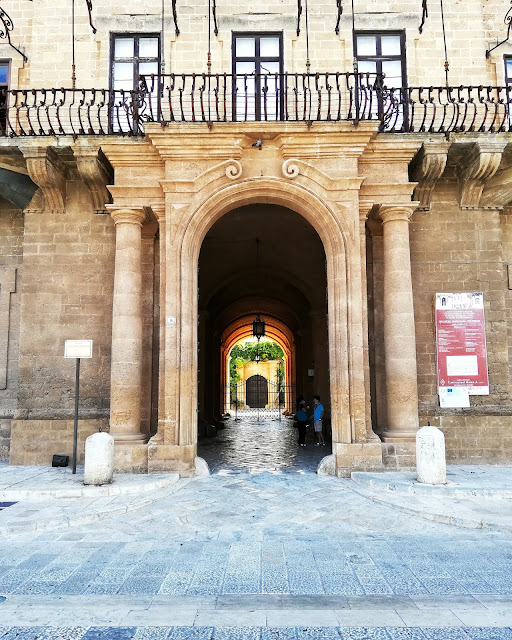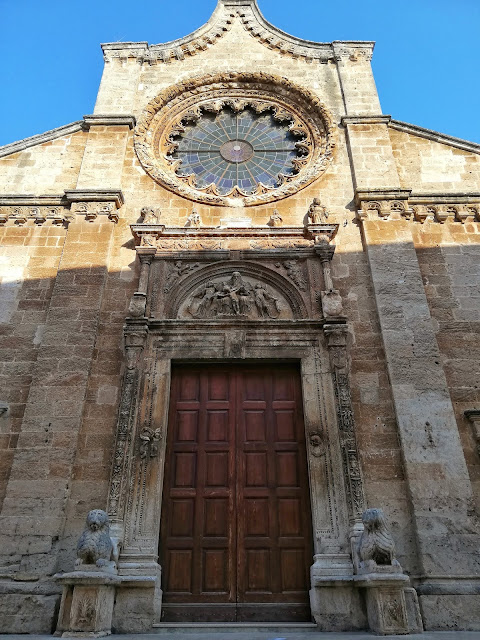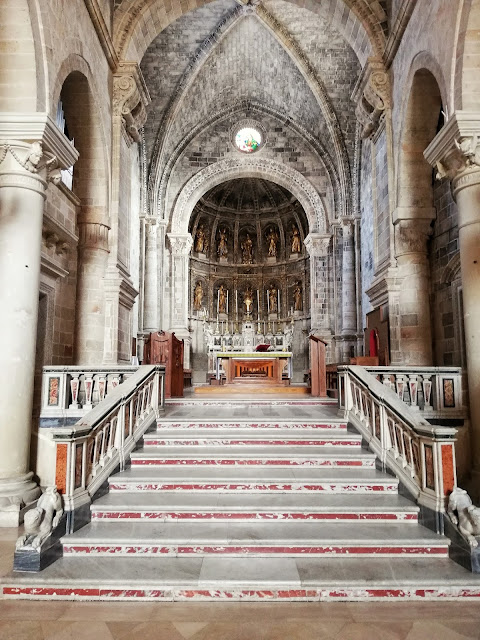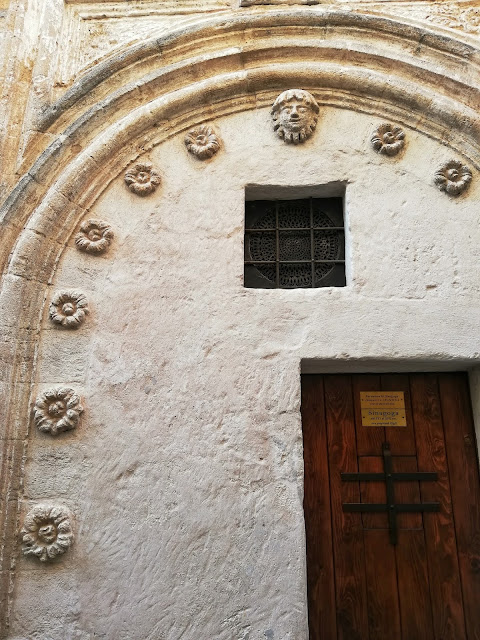Negli ultimi anni mi è capitato spesso di andare a Manduria, ma mi sono sempre fermata
fuori dalla città, nelle campagne, nel bosco e al mare. A mia discolpa posso
dire che ci sono sempre andata nel mese di agosto, quando il caldo della Puglia
tende a far svuotare le città verso aree più fresche. Visitare Manduria con
38°C non è esattamente allettante, ma mi ero ripromessa di tornarci con una temperatura
più accettabile. Quel momento è arrivato il mese scorso e adesso colgo
l’occasione per proporti un walking tour
per il centro storico di Manduria, perfetto da fare in autunno.
Attraversiamo Porta Sant’Angelo per entrare nel centro
storico di Manduria e iniziamo con il nostro walking tour.
#1 PALAZZO IMPERIALI-FILOTICO
Sorveglia Piazza Garibaldi, in pieno centro, questo palazzo
tardo-barocco. Nella facciata ha un che di familiare: ah sì, i balconi! Sono
detti a petto d’oca e ora ricordo dove li ho già visti: a Martina Franca sulla facciata
del Palazzo Ducale, da cui venne l’ispirazione.
Questo palazzo venne costruito sopra i resti di un castello
precedente con l’intento di offrire riposo agli ospiti del principe che
andavano a caccia al cinghiale nei boschi di Arneo.
Purtroppo non è visitabile: ci dobbiamo accontentare di
vederne gli esterni.
#2 IL CALVARIO
Andiamo più avanti e attraversiamo Piazza Vittorio Emanuele
II. Lì, all’incrocio, spicca con i suoi colori
e la sua “confusione” il Calvario.
Avvicinandoci cominciamo a distinguere le figure e a dare un senso alla
composizione. Come intuibile dal nome, è la rappresentazione del Monte
Calvario.
Nel ‘800 i sacerdoti liguorini vollero creare un luogo che
potesse esortare i fedeli alla preghiera. Con questo scopo posero cinque croci
nel terreno a costruire un vero e proprio Calvario. Successivamente l’arciprete
Marco Gatti, non particolarmente contento dell’estetica di questo punto di
ritrovo, incaricò Giuseppe Renato Greco di abbellire il monumento. Il buon
Giuseppe decise di farlo usando quello che la tradizione del luogo gli offriva:
con l’aiuto della popolazione, raccolse conchiglie e ceramiche della tradizione
di Manduria e Laterza e dopo 40 anni portò a termine la sua impresa e possiamo
ammirare il risultato del suo lavoro di ricerca, collezione e riutilizzo.
Il mio consiglio è, dopo un’occhiata complessiva, di
guardarlo nei particolari, per scoprirne ogni dettaglio.
#3 LA CHIESA MATRICE
Inoltriamoci per le vie del centro storico e incamminiamoci
verso la Chiesa Matrice. Per le vie
contorte del centro sembra un po’ di camminare alla cieca, ma non temere,
perché, all’improvviso, tra le case appare la chiesa in tutta la bellezza ed
eleganza della sua facciata, con il rosone gotico che cattura lo sguardo e
l’imponenza del portale centrale.
L’interno è un piccolo tesoro dalle calde sfumature della
pietra locale con la quale è stato costruito l’edificio.
La parte che naturalmente cattura l’attenzione e attira
inesorabilmente è il presbiterio e l’abside, con la scalinata che ti invita a
salire e allo stesso tempo ti incute quel timore reverenziale che non ti fa muovere
un passo in più. Rimani pure a guardare tutti i dettagli, le statue , l’altare,
le sculture ai piedi della scalinata, il pulpito ligneo e il battistero del 1534.
Uscendo, andiamo a sinistra e attraversiamo il cancello
accanto la chiesa. Porta in un vicolo che sembra cieco, ma una porticina dà su
una piazza. Attraversa la porta e goditi l’apparizione del campanile. Siamo ai
suoi piedi e da qui si possono ammirare da vicino le decorazioni di ogni piano
e notare come si differenziano l’uno dall’altro, essendo di epoche diverse.
#4 GHETTO DEGLI EBREI
Camminando lungo Vico degli Ebrei raggiungiamo la Sinagoga.
La riconosci dalle decorazioni floreali sulla facciata, che la fanno spiccare
tra le altre case del vicolo.
#5 MUSEO DELLA CIVILTÀ DEL VINO PRIMITIVO DI MANDURIA
Per l’ultima tappa di questo walking tour lasciamo il centro
storico e ci incamminiamo verso la stazione. Con una passeggiata di 10 minuti
arriviamo al Museo della Civiltà del
vino Primitivo di Manduria, fiore all’occhiello e vanto di questa città.
Non possiamo lasciare Manduria senza assaggiare il suo prodotto tipico per
eccellenza.
Ho scritto un intero post sul museo, in cui ho parlato della
visita e della degustazione dei deliziosi vini che la cantina Produttori di
Manduria produce. Se vuoi saperne di più, ti lascio il link qui.
Così termina il nostro walking tour a Manduria. Ti consiglio
questa passeggiata per una gita fuori porta, per un sabato o una domenica diversi
dal solito. Manduria è molto frequentata soprattutto in estate, complice il suo
mare da sogno, ma è una destinazione da scoprire anche in autunno con le
bellezze e le bontà che la città offre.
.................................
An Autumn Walking Tour in Manduria
In the last
years I’ve often gone to Manduria,
but I’ve always spent my stay out of the town, in the countryside, in the wood
and on the beach. In my defense, I can say that I’ve always gone there in
August, when the hot weather of Apulia makes people leave the town toward
cooler areas. Visiting Manduria with 38°C isn’t exactly attractive, but I
promised myself to come back with a more acceptable temperature. That moment
came last month and now I take the opportunity to suggest you a walking tour in the old town centre of
Manduria, perfect to be done during autumn.
We pass through
Porta Sant’Angelo to enter the old town centre of Manduria and start with our walking
tour.
#1 PALAZZO IMPERIALI-FILONICO
This late Baroque palace guards Piazza Garibaldi, in the
centre. On the façade there’s something familiar: oh yes,
balconies! They’re called goose-breast-shaped balconies and now I remember
where I saw them: in Martina Franca on the façade of Palazzo Ducale, from where
the inspiration came.
This palace
was built on the rest of an old castle with the aim of offering some rest to
the prince’s guests who went boar hunting in Arneo woods.
Unfortunately
it’s not open to visitors: we must be content to see it from outside.
#2 THE
CALVARY
Let’s go
ahead and cross Piazza Vittorio Emanuele II. There, at the crossroad, the Calvary stands out with its colours and
“confusion”. Getting closer, we can distinguish the figures and give a sense to
the composition. As you can guess from the name, it’s the representation of
Mount Calvary.
In the 19th
century, the priests called Liguorini wanted to create a place to urge the
faithful to pray. So, they put five crosses in the land to build a proper
Calcary. Later, archpriest Marco Gatti, not really satisfied with the aesthetic
of this meeting point, instructed Giuseppe Renato Greco to beautify the
monument. The nice Giuseppe decided to do it using what the tradition of the
place offered: with the help of the population, he collected shells and
ceramics of Manduria and Laterza tradition and after 40 years he ended his work
and we can admire the result of his work of research, collection and re-use.
My suggestion
is, after an overall glance, to look at the details to discover all of them.
#3 THE MOTHER
CHURCH
Let’s venture
along the alleys of the old town centre and walk toward the Mother Church. Among the twisted alleys
of the centre, it seems a bit to walk in blind, but don’t be afraid, because,
suddenly, among the houses, the church appears in the beauty and the elegance
of its façade, with the Gothic rose window and the grandeur of the central
portal.
Inside it’s a
little treasure with the warm nuances of local stone with which the building
has been built.
The part that
naturally catches the attention and attracts inevitably is the presbytery and
the apse, with the staircase that invites you to go upstairs and at the same
time commands that awe that doesn’t make you take a step. Take your time and
see the details, the statues, the altar, the sculptures at the feet of the
staircase, the wooden pulpit and the baptistery of 1534.
Going
outside, we turn left and go through the gate near the church. It brings in an
alley that seems to have a dead end, but a little door opens on a square. Go
through the door and enjoy the appearance of the tower bell. We are at its feet
and from here you can admire closely the decorations of each floor and notice
how different they are from each other, being of different periods.
#4 THE GHETTO
OF THE JEWS
Let’s come
back before the Mother Church. In front of its entrance there’s an arch: it’s
the entrance of the ghetto of the Jews.
As in many areas of Apulia, also Manduria had its Jewish community, apparently
since the 13th century, when the Swabian reigned in Apulia.
Walking along
Vico degli Ebrei, we reach the Synagouge. You recognize it from floral
decorations on the façade, that make it stand out among the other houses of the
alley.
#5 THE MUSEUM
OF PRIMITIVO WINE CULTURE
For the last
stop of this walking tour we leave the old town centre and walk toward the train
station. With a walk of 10 minutes, we arrive at the Museum of Primitivo Wine Culture of Manduria, the flagship and the
pride of this town. We can’t leave Manduria without tasting its local product
par excellence.
I wrote a
whole blogpost about the museum, where I talked about the visit and the tasting
of the delicious wines produced by the winery Produttori di Manduria. If you
want to know more, I leave the link here.
That’s the
end of our walking tour in Manduria. I suggest this walk for a day trip, for a
Saturday or a Sunday different from the usual. Manduria is very popular
especially during summer, favoured by its sea dream, but it’s a destination to
be discovered also in autumn with the beauties and the tastiness that the town
offers.









Commenti
Posta un commento
Feel free to leave a comment!
I would be glad to know your opinion! ;)
Thank you! :)